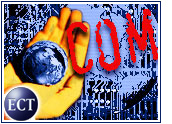
What’s in a name? Not much, according to Shakespeare. But today, the answer is “plenty” — especially when you’re talking about the intersection of domain names with trademarks.
The Internet Corporation for Assigned Names and Numbers — most commonly known as ICANN — is a nonprofit corporation that was set up in California to administer several core Internet structures, including the first round of top-level domains (TLDs) like .com and .net. ICANN grants accreditation to registrars, which provide domain names to those seeking them.
Almost as soon as the idea of Internet domain names got off the ground, a landgrab began as people realized that these domains could be worth serious money. At this point, an activity called cybersquatting arose.
Cybersquatters deliberately register known name brands or company names as domain names — like coke.com or chevy.com — with the intent of selling those domains to the name-brand owner at a later date. In a recent example, the government of New Zealand paid US$500,000 to U.S.-based Virtual Countries to obtain rights to the domain name “newzealand.com.”
The Legal Battles Begin
As one would expect in a situation with such high stakes, legal battles over domain names soon began. In an effort to reduce use of the courts to decide these cases, ICANN designated five international bodies to arbitrate disputes involving abuse of trademarked names. Cases not involving trademarks, or in which no abuse or bad faith is evident, still go to courts.
The largest of these international bodies, handling more than 60 percent of disputes worldwide, is the World Intellectual Property Organization (WIPO), based in Geneva, Switzerland. The process used by it and the other “resolution providers” is called the Uniform Domain Name Dispute Resolution Policy (UDRP) and was written by ICANN based on WIPO research.
Under terms of the UDRP, a trademark holder brings a complaint to the resolution provider of its choice, citing a “respondent” who has registered a name identical or similar to the trademark, and to which the respondent has no claim. The disputed registration must have been registered and used “in bad faith.” Then, one arbitrator — or a panel of three arbitrators (at a higher cost) — delivers a binding judgment.
ICANN has attracted widespread and intense criticism on several fronts, including design and implementation of the UDRP. One of the most basic objections is that the burden of proof is not on the “prosecution” — as in normal law — but on the “defendant.” This is said to invert the usual “innocent until proven guilty” basis of law in the western world.
Also, the fact that the complainant trademark owner can choose the venue (resolution provider) for the case is said to create an unhealthy practice called “forum-shopping.”
UDRP Highly Biased
According to former ICANN board member Karl Auerbach, “the UDRP system is highly biased, in that it induces the UDRP decision-maker to decide in favor of the plaintiff, because the plaintiff is the one who picks the decider.”
Auerbach is chief technical officer at California-based InterWorking Labs. He has been a persistent gadfly on issues of Internet governance, privacy and accountability. He was elected to the board of ICANN in the days when the organization still had elections, and is trenchant in his criticism of it.
“The UDRP is first a weapon,” he told TechNewsWorld, “which can only be used only by those owning trademarks. If you have a church or a god or a school or a theater company or whatever, you don’t have a trademark in it, and you can’t use the UDRP to protect your rights. Why do these names lose out to trademarks? Only because the trademark people wrote the UDRP. It was railroaded through ICANN without any real public process.” Many others agree.
About 80 percent of UDRP cases are decided in favor of the plaintiff; the actual numbers vary between resolution providers. How you view that figure depends on where you stand on the issue.
Corporate Bullies
For Auerbach and others, this is evidence of corporate bullies beating down creative independents.
For Francis Gurry, assistant director general of WIPO and director of the WIPO Arbitration and Mediation Center that handles UDRP cases, it’s simply proof of how often disputed names are in fact registered in bad faith.
“The UDRP only applies where there is an abuse of the domain name and where on one side you have rights — namely the trademark owner — and on the other side you have no rights or legitimate interests,” he told TechNewsWorld. “If there is any right or legitimate interest on the part of the domain name applicant, it’s not a case for the UDRP.”
Gurry feels the process is working well at WIPO on two counts. “One: we’re sticking to time limits. It’s not taking two years to resolve a dispute; it’s taking more like 50 days.” And while noting that other factors, such the end of the dot-com bubble, might play a role, he believes UDRP has been effective in reducing the amount of cybersquatting. “Cybersquatting is still there,” he said. “There are still many disputes, but not as many.”
In the Long Term
Gurry also believes the UDRP doesn’t stifle creativity. “I could see some of those criticisms might be directed at other aspects of what some people perceive to be excessive intellectual property protection elsewhere — in relation to copyright, for example. I don’t comment on those. But as far as the UDRP is concerned, I think it’s pretty simple, and it can’t be considered to be stifling creativity in any way.”
In fact, for the “little guy” protecting a name, he noted, it’s much cheaper than court.
What of domain name ownership in the long-term? Many side with Karl Auerbach, who says “we’re seeing, potentially, the end of the ‘end-to-end’ principle on the Internet; the notion that any person can communicate directly with any other person.”
Others would agree with Gurry that “domain names are essential … in the branding process of joining people together on the Internet. I can’t see that they’re going to diminish in importance. On the contrary, I think that their importance will increase, if anything.”










































